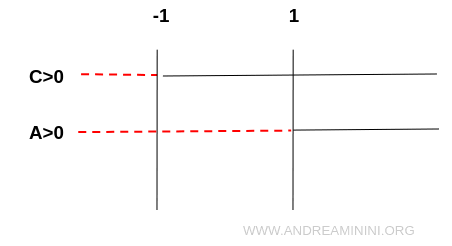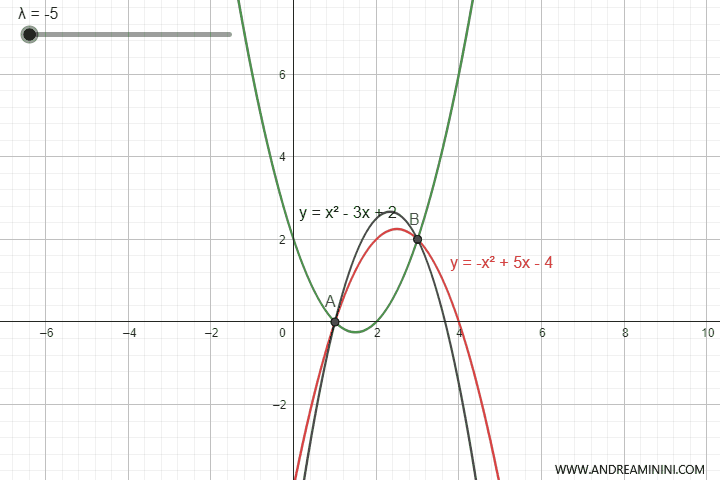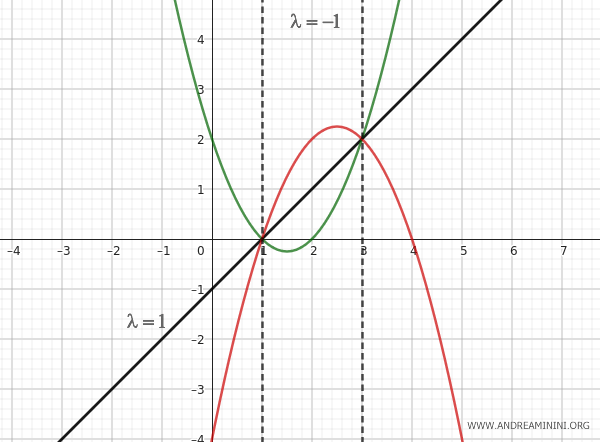Analyzing the Concavity of a Family of Parabolas
To examine the concavity of a family of parabolas as the parameter \(\lambda\) changes, I need to look at how the coefficient of the \(x^2\) term in the general equation of the family varies.
$$ Ax^2 + Bx + Cy + D = 0 $$
Where the coefficients are:
$$ A = a_1 + \lambda a_2 $$
$$ B = b_1 + \lambda b_2 $$
$$ C = 1 + \lambda $$
$$ D = c_1 + \lambda c_2 $$
The concavity of the parabola is determined by the sign of the coefficient of the \(x^2\) term, which is \( A \), and the sign of the variable \( y \).
For a parabola parallel to the y-axis, if \(C > 0\) then:
- If \(A < 0\), the parabola opens upwards.
- If \(A > 0\), the parabola opens downwards.
Conversely, if \(C < 0\) then:
- If \(A < 0\), the parabola opens downwards.
- If \(A > 0\), the parabola opens upwards.
Regardless of the sign of \(C\), if \(A = 0\), the equation represents a line, not a parabola.
Note: The equation \( Ax^2 + Bx + Cy + D = 0 \) can be rearranged to \( Cy = -Ax^2 - Bx - D \). Therefore, considering for simplicity the case where \(C > 0\), if \(A < 0\), the coefficient \(-Ax^2\) becomes positive, and the curve opens upwards (concave downwards). Conversely, when \(A > 0\), it opens downwards (concave upwards).
Once the critical values of \(\lambda\) are found where \( A = 0 \) and the parabola transitions from opening upwards to opening downwards (or vice versa), I use the critical value found to study the sign and determine the intervals of \(\lambda\):
A Practical Example
I need to study how the concavity changes as \(\lambda\) varies in the family of parabolas given by:
$$ (y - x^2 + 3x - 2) + \lambda (y + x^2 - 5x + 4) = 0 $$
I start by rewriting the equation in a simpler form. Expanding and simplifying the equation:
$$ y - x^2 + 3x - 2 + \lambda y + \lambda x^2 - 5\lambda x + 4\lambda = 0 $$
$$ (1 + \lambda)y + (\lambda-1)x^2 + (3 - 5\lambda)x + (-2 + 4\lambda) = 0. $$
This is the general equation for the family of parabolas.
For simplicity, I can rewrite it in this form:
$$ Ax^2 + Bx + Cy + D = 0 $$
Where:
$$ A = \lambda -1 $$
$$ B = 3 - 5\lambda $$
$$ C = 1 + \lambda $$
$$ D = -2 + 4\lambda $$
The concavity of a parabola depends on the sign of the coefficient of the \(x^2\) term, which is \( A \):
$$ A = \lambda -1 $$
However, I also need to consider the sign of \(C\) because it affects the sign of the variable \( y \):
$$ C = 1 + \lambda > 0 $$
$$ \lambda > -1 $$
Thus, the coefficient \(C\) is positive in the interval (-1, ∞) and negative in the interval (-∞, -1) of the parameter \( \lambda \).
Now, let's study the sign of the term \( A \):
$$ A = \lambda -1 > 0 $$
$$ \lambda > 1 $$
Therefore, the coefficient \(A\) is positive in the interval (1, ∞) and negative in the interval (-∞, 1) of the parameter \( \lambda \).

In the interval \(\lambda \in (-1, ∞)\) where the coefficient \(C\) is positive:
- The parabola opens downwards in the interval (1, ∞) because \( A > 0 \)
- The parabola opens upwards in the interval (-1, 1) because \( A < 0 \)
In the interval \(\lambda \in (-∞, -1)\) where the coefficient \(C\) is negative:
- The parabola opens downwards in the interval (-∞, 1) because \( A < 0 \)
To summarize:
- For \(\lambda > 1\), the parabola opens downwards (concave upwards).
- For \(-1 < \lambda < 1\), the parabola opens upwards (concave downwards).
- For \(\lambda < -1\), the parabola opens downwards (concave downwards) because the \( y \) term becomes negative, affecting the overall shape of the parabola.

In this example, at the critical points \(\lambda = 1\) and \(\lambda = -1\) where the parabola transitions from concave to convex (or vice versa), the parabola degenerates into a line.
At \(\lambda = 1\), the degenerate parabola passes through both base points A and B of the family, while at \(\lambda = -1\), the degenerate parabola appears as a pair of lines parallel to the axis of symmetry.

Note: In a family of parabolas, as the parameter \(\lambda\) changes, both the sign of the coefficient \(A\) and the coefficient \(C\) change. Both of these terms affect the opening of the parabola in the graph.
And so on.
